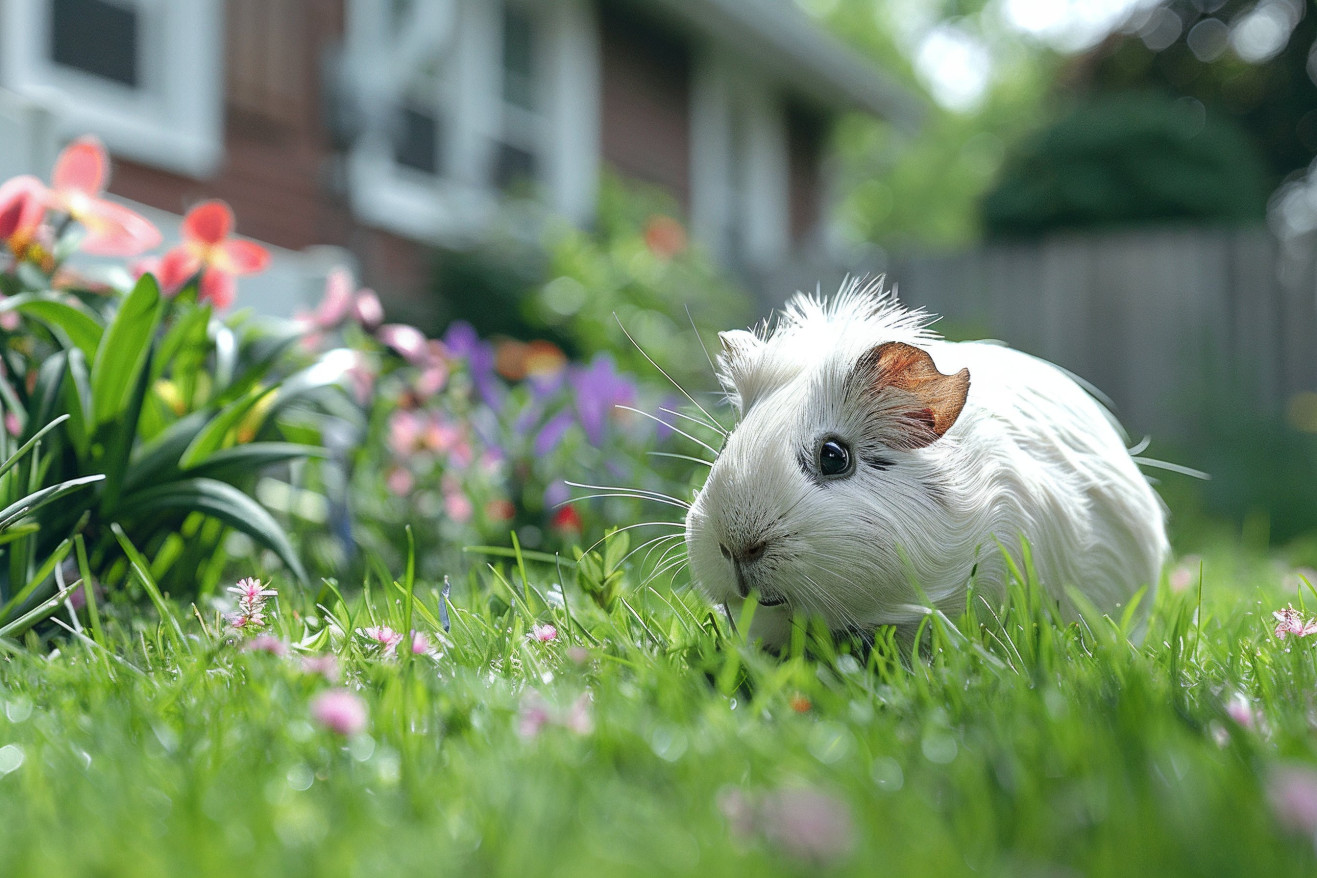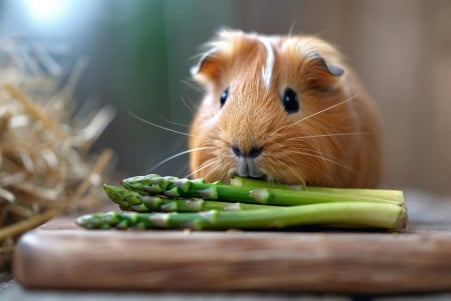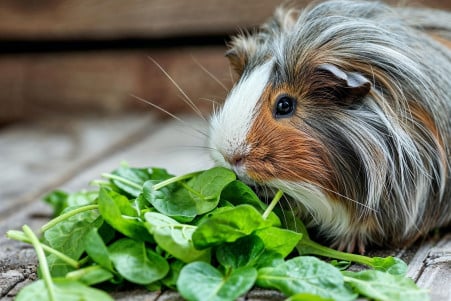Can Guinea Pigs Eat Grass? A Comprehensive Guide
12 April 2024 • Updated 11 April 2024

If you’ve ever looked at your freshly mowed lawn and thought about letting your guinea pig have a little taste, you’re in luck. Guinea pigs can eat grass, and it’s an important part of their diet. Not only is it high in fiber, but it also provides them with essential nutrients like vitamins C and K and magnesium.
To make sure you have all the information you need about your guinea pig’s grass consumption, we’ve referenced animal nutritionists and veterinarians to provide you with a complete overview. This includes the best types of grass, how much they should eat, and best practices for letting them eat grass. We’ve also included information about the potential risks of letting your guinea pig eat grass if you treat your lawn, so you can make sure you’re keeping your pet safe and healthy while letting them enjoy this delicious snack.
Can guinea pigs eat grass?
How to Add Grass to a Guinea Pig's Diet
Since guinea pigs are natural grazers, it's important to make sure that their diet is high in fiber from grass hay and fresh grass. In fact, grass should make up 80-90% of a guinea pig's diet since it's high in fiber, which is essential for good gut health and keeping their teeth from getting too long.
In addition to grass, guinea pigs should also be fed a daily serving of fresh vegetables, such as bell peppers, carrots, and leafy greens, to ensure they get the vitamins and minerals they need. Aim for 1 cup of fresh vegetables per guinea pig per day, which should make up 10-20% of their diet. Pellets can also be used to supplement a guinea pig's diet, but they should be limited to 1/4 cup per guinea pig per day to prevent obesity.
Feeding guinea pigs too many sugary fruits or too many pellets can lead to a variety of health problems, including obesity and digestive issues. If you're introducing grass or fresh grass to your guinea pig's diet, make sure to do so gradually over the course of a week or two to give their gut bacteria time to adjust and prevent issues like bloating and diarrhea. In general, it's best to make sure that guinea pigs have access to grass hay at all times so that they can graze throughout the day and get plenty of fiber. This way, their diet will be well-balanced and meet all of their nutritional needs while also allowing them to eat the way they would in the wild.
Safe Grass Varieties and Feeding Guidelines
While most fresh grasses are safe for guinea pigs to eat, there are some high-calcium and high-protein grasses that should be avoided. Small Pet Select notes that good grasses to feed guinea pigs include timothy hay, oat hay, and freshly hand-picked lawn grass that is free from pesticides, herbicides, and other chemicals.
Grass clippings from a lawn mower should be avoided because the way it's processed can cause fermentation that is not safe for guinea pigs. Guinea Pigs Australia advises that it's best to always feed freshly hand-picked grass to avoid any digestive issues.
When you first start feeding grass, you should only let your guinea pig graze for short periods, such as 20 minutes, and then gradually increase the time to allow your guinea pig's digestive system to get used to the new food. The Shropshire Guinea Piggery warns that if you increase the time too quickly, your guinea pig may experience issues like bloat, which can be fatal.
It's also important to make sure that your guinea pig has access to fresh water, as grass can be dehydrating and lead to urinary problems if your pet doesn't drink enough. By following these safe grass varieties and feeding guidelines, you can make sure that you're feeding this nutritious forage to your guinea pig in a way that will keep them healthy.
Fresh Vegetables and Fruits
In addition to hay, guinea pigs need fresh vegetables and fruits to stay healthy. The Southern California Guinea Pig Rescue recommends feeding guinea pigs one to one and a half cups of fresh veggies per pig per day. The majority of this should be leafy greens, such as green leaf lettuce, red leaf lettuce, butter lettuce, endive, and cilantro. Other veggies, such as green bell peppers, tomatoes, zucchini, and carrots, can also be included.
Veggies that are high in calcium, such as kale and spinach, should be fed in small amounts because they can cause health problems like bladder stones, according to PDSA. Fruits, including apples, berries, and melons, can be given as treats, but they should be limited because they are high in sugar, as noted by GuineaPigGles.
Feeding a variety of vegetables, herbs, and occasional fruits will help ensure that your guinea pig gets the nutrients and mental stimulation they need, according to the RSPCA. This, along with the hay portion of their diet, will help ensure that your guinea pig is as healthy and happy as possible.
How to Monitor Grass Intake and Potential Health Risks
Although grass is a necessary part of a guinea pig's diet, it can also cause health problems such as bladder stones, obesity, and digestive issues if consumed in excess. The Guinea Pig Forum notes that this makes it important to ensure that your guinea pig eats a balanced diet that includes grass but doesn't overdo it, since there are no official guidelines for how much grass a guinea pig should eat.
To avoid obesity, you should regularly weigh your guinea pig and adjust the amount of grass and pellets you feed them as needed. PDSA notes that the diet should be mostly grass and hay, with pellets making up a small portion.
Another potential risk is that grass can contain parasite eggs, so the vet interviewed by Canadian Living says that guinea pigs that eat a lot of fresh grass may need to be dewormed regularly.
In addition, sudden changes in diet or overeating can lead to life-threatening digestive problems like bloat. The Shropshire Guinea Piggery recommends introducing fresh grass to your guinea pig's diet slowly to give their digestive system time to adapt.
If you notice any changes in your guinea pig's diet, weight, or behavior, you should contact a vet to make sure that there aren't any underlying health problems. By monitoring their grass intake and making sure that they get medical care when they need it, you can make sure that your guinea pig has a long, healthy life while eating this important part of their diet.
Conclusion: Grass as a Healthy Dietary Staple
Grass is an essential part of a guinea pig's diet, providing fiber, vitamins, and minerals. Grass should be the primary component of a guinea pig's daily diet, which should also include fresh vegetables, a small amount of pellets, and the occasional fruit treat.
Grass should be fed in moderation, as overconsumption can lead to health problems like bladder stones and obesity. Make sure you follow safe grazing guidelines, keep an eye on your guinea pig's weight and health, and consult a veterinarian if you have any concerns. Grass can be a healthy and enjoyable part of your guinea pig's diet when fed in the right amounts and with the right variety.


